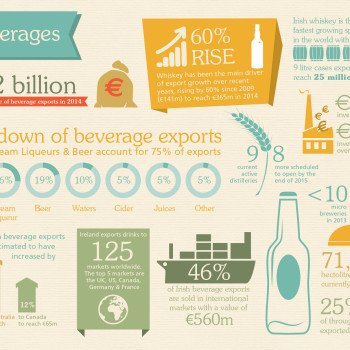International markets driving export growth, Bord Bia
14 January 2015
A 4% increase has seen Irish food and drink exports reach a record high of almost €10.5 billion in 2014, according to Bord Bia’s Export Performance and Prospects Report, launched today (Tuesday, 13 January, 2015).
Aidan Cotter, chief executive, Bord Bia outlined the background to the fifth consecutive year of export growth for the food and drink industry. He said that, in 2014, exports grew by 4%, representing an expansion of 45% or €3.2 billion since 2009. The strongest performing sectors were dairy product and ingredients which exceeded the €3 billion mark (+3%), prepared foods (€1.8 billion, +8%) and seafood (€540 million, +8%).
He highlighted the significant shift in the destinations for Irish exports in 2014 with international markets showing renewed growth, reflected in a 15% increase in trade to stand at €3 billion or 29% of total food and drink exports.
This shift in market destination was marked by increases in the value of exports to Asia to reach €850 million (+45%) as well as significant increases to North America (€740 million, +18%), the Middle East (€330 million, +11%) and Africa (€610 million, +9%). Within this, China recorded a further increase of almost 40% to reach approximately €520 million. China is now Ireland’s second largest export market for dairy, compared to 13th in 2008.
While it remains Ireland’s most significant export market, the share of exports destined for the UK eased slightly though the value showed little change at €4.2 billion or 40% of export share. Stronger export values for beverages, prepared foods, mushrooms and poultry helped offset lower beef and dairy values.
The value of exports to other EU destinations grew by 2% to reach €3.3 billion equating to 31% of total exports reflecting largely static consumer price inflation across the Eurozone.
Ireland’s exports benefited from the effects of a weak euro against sterling and the US Dollar, however a strengthening euro against the Russian Rouble combined with trade suspensions had a significant negative impact on Irish exports to that region with exports falling by an estimated 30% to €170 million.
Welcoming the positive results, the Minister for Agriculture, Food and the Marine Simon Coveney TD said that: “Since 2009 food and beverage exports have increased by 45% compared to Irish merchandise exports which are 5% higher. Our strategy for exports is clear and our pursuit of the targets set out in Food Harvest 2020 is relentless.”
Prospects for 2015
Aidan Cotter outlined the factors that point to 2015 being a more challenging year to maintain recent growth. While the abolition of milk quotas in April 2015 is expected to lead to an increase in milk output of more than 10% for the year, the current weakness of global dairy markets is negatively impacting on price levels and recent forecasts from Rabobank suggest this trend will persist well into 2015.
Cattle supplies are expected to ease by more than 120,000 – 150,000 head in 2015, which will lead to export volumes falling by around 8%. However, some recovery in cattle prices is anticipated. Much will depend on demand developments in more established markets with consumer sentiment to remain a critical driver.
The prepared foods and beverages sectors both face competitive market environments, although both have shown a strong ability to diversify over recent years. Further strong growth potential exists for whiskey in particular, while a number of key prepared food categories such as confectionery, ready meals and bakery are expected to record further growth.
The export outlook for the seafood sector will depend on product supply. However, value added salmon exports from Ireland are showing strong increases and this trend is expected to continue in 2015.




 Print
Print




Fans 0
Followers